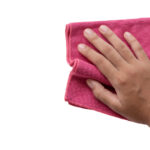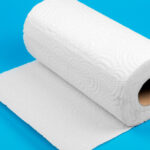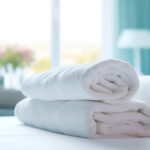A microfiber towel is one of the most versatile cleaning tools you can have. With its ultra-fine fibers that are split into even tinier strands, a microfiber towel can clean, dust, polish, absorb spills, and so much more.

Unlike regular towels made of materials like cotton, microfiber towels have a very large surface area that allows them to pick up and hold more dust, dirt, and liquid. The positively charged microfiber material also attracts negatively charged dust, grease, and grime almost like a magnet. This makes microfiber towels far more effective at cleaning than traditional materials.
Dusting
Microfiber towels are excellent at attracting and trapping dust particles thanks to the positively charged microfibers. This makes dusting furniture, blinds, baseboards, and other surfaces much faster and easier.
To use a microfiber towel for dusting:
- Use a dry microfiber towel and wipe surfaces using light, quick motions. The microfibers will cling to dust.
- For heavier dust, lightly dampen the towel. The water will help lift stuck-on dust. Wring out well so the towel doesn’t leave moisture behind.
- Dust from top to bottom in a room. This stops dust falling onto already cleaned areas.
- Fold the towel into quarters and unfold a fresh side as you go so you maximize the cleaning surface.
Key Takeaway: Dry or slightly damp microfiber towels lift dust off surfaces much better than traditional dusting cloths or paper towels.
Kitchen Cleaning
Microfiber towels are safe and effective on all kitchen surfaces. Use them to clean countertops, backsplashes, appliances, cabinet doors, and more.
To clean the kitchen with microfiber:
- Use an all-purpose cleaner or mix a solution of vinegar and water. Spray or dampen the microfiber towel.
- Wipe down surfaces using a scrubbing motion to lift grease and grime.
- Switch to a dry side of the towel to buff surfaces to a streak-free shine.
- Use a fresh towel for cleaning really dirty areas like the stovetop or microwave.
- To clean stainless steel, rub in the direction of the grain using a vinegar solution. Dry completely with a dry towel.
- Microfiber can be used on granite, marble, and other stone countertops. Avoid harsh cleaners that can degrade the sealant.
Key Takeaway: Microfiber towels clean kitchen messes like grease easily without scratching even delicate surfaces like stainless steel.
Window Cleaning
The super absorbent and lint-free properties of microfiber make window cleaning a breeze. Microfiber towels soak up cleaning solution and leave glass sparkling.
To clean windows with microfiber:
- Use a spray bottle with a blue dawn and water solution or an all natural window cleaner.
- Work from top to bottom. Spray the glass and use a damp microfiber towel to scrub dirt and grime.
- Squeeze out excess liquid as you go to avoid drips.
- Buff dry with a dry microfiber towel. Rub in overlapping circles.
- For outside windows, rinse first with a hose if very dirty. Use an extendable squeegee after cleaning to remove all water.
Key Takeaway: Microfiber towels clean windows streak-free by absorbing all the dirty window cleaning solution instead of leaving it to dry on the glass.
Cleaning Electronics
Microfiber towels are the perfect cleaning companion for phones, tablets, TV screens, laptops, and other electronics. They safely remove smudges, dust, and fingerprints.
To clean electronic screens and devices:
- Always turn off and unplug the device first.
- lightly dampen the microfiber towel with water. Do not soak it.
- Gently wipe the screen or device exterior using a light touch.
- Flip the towel over and dry the surface. Rub gently to polish the screen.
- A barely damp microfiber towel can clean between keyboard keys. Allow to fully dry before using.
- Don’t use excessive pressure and avoid liquid near any openings to prevent damage.
Key Takeaway: Microfiber cloths lift dirt from delicate electronics without scratching or damaging the screens or exterior.
Cleaning Walls, Baseboards and Trim
Microfiber towels are great for dry dusting walls. Dampen them for scrubbing scuff marks on painted trim and baseboards.
To clean walls and trim:
- Use a dry microfiber towel and run it along walls lightly to collect cobwebs and dust. Fold to a new side periodically.
- For painted trim, dampen a towel with water and add a small amount of baking soda. Test on an inconspicuous spot first.
- Use a scrubbing motion on scuffs and wipe away grime. Rinse the towel and wipe again if needed.
- Buff dry with a clean side of the microfiber towel until no moisture remains.
Key Takeaway: Microfiber can dust walls and scrub away scuffs on painted trim without damaging the paint.
Cleaning Leather
Microfiber towels can safely clean leather furniture, shoes, purses, and clothing when used properly. Always test an inconspicuous area first.
To clean leather items:
- Vacuum or dust first to remove any dirt or debris.
- Dampen a microfiber towel with plain water and wipe down the leather to clean.
- For deeper cleaning, use a small amount of mild leather cleaner. Use very little and work it into a microfiber towel so it’s barely damp. Wipe the leather gently.
- Rinse the towel frequently and work in small sections to avoid over-wetting the leather.
- Let leather dry completely between sections. Then buff gently with a dry microfiber towel.
Key Takeaway: Slightly damp microfiber lifts dirt from leather and avoids over-wetting, which can damage leather items.
Cleaning the Bathroom
Microfiber towels are the ultimate bathroom cleaning helper. Use them dry or wet to clean fixtures, mirrors, counters, floors, and more.
To clean the bathroom with microfiber:
- Dry microfiber lifts hair and dust from surfaces like the counter and mirror.
- Dampen towels to clean sinks, faucets, glass shower doors, and tile. Use a non-abrasive cleaner or baking soda paste.
- Use gentle pressure and a circular scrubbing motion on tile, grout, and bathtub surfaces.
- Rinse frequently and dry with a separate ‘bathroom towel’ for best results. Replace bathroom microfiber towels often.
- To clean floors, attach a dry microfiber mop head to reach corners and baseboards.
Key Takeaway: Microfiber cleaning towels are highly effective at cleaning all bathroom surfaces from mirrors to floors when used properly.
Cleaning Stainless Steel Appliances
Microfiber can make stainless steel appliances shine. It removes fingerprints and cleans grease easily.
To clean stainless steel appliances:
- Wipe down with a dry microfiber cloth first to remove loose dirt and dust.
- Mix a non-abrasive stainless steel cleaner with water in a spray bottle. Or use a mix of equal parts water and vinegar.
- Mist the surface and use a clean microfiber towel to spread the cleaner over the surface.
- Rub gently with the grain of the stainless steel. Use a circular scrubbing motion to lift stuck-on grime.
- Rinse the towel frequently in clean water. Use a dry side of the towel to buff away any moisture and fingerprints.
Key Takeaway: Microfiber lifts fingerprints and grease from stainless steel without scratching the delicate surface when used properly.
Drying Dishes
Large microfiber towels work great for drying dishes since they absorb water quickly and don’t leave lint behind.
To dry dishes with microfiber:
- Choose a large waffle weave microfiber towel. This texture absorbs water fast.
- Drape the towel over your shoulder or arm for easy access while drying.
- Gently blot dishes to absorb water, instead of wiping which can push around water droplets.
- Flip towel to dry sides periodically.
- Lay flat or hang to dry between uses so it stays fresh. Wash dish drying towels frequently.
Key Takeaway: Large, absorbent microfiber towels dry dishes faster and more effectively than regular cotton dish towels.
Cleaning and Drying Cars
For car washing and detailing, microfiber towels are perfect for washing, drying, and waxing. Their gentle touch prevents scratches.
To clean and detail cars with microfiber:
- Use separate towels for washing, drying, and waxing. Different colors help keep them separate.
- For washing, use a mitt or towel with a scrubbing side. Use a soap and water solution and rinse mitt or towel frequently.
- Dry gently with a waffle weave microfiber towel, using a patting motion instead of rubbing hard.
- For waxing, choose an ultra-soft and smooth microfiber to buff and shine.
- Fold towels frequently to expose clean sides. Wash after each use.
Key Takeaway: Color-coded microfiber towels prevent swirl marks and scratches on car paint when used properly for washing and drying.
Cleaning Car Interiors
Microfiber towels safely clean leather, vinyl, plastic, glass and delicate surfaces inside vehicles. Their lint-free properties make them ideal for cars.
To clean car interiors:
- Vacuum seats and floor mats first to lift debris.
- Dampen a microfiber towel with an interior car cleaner or diluted all-purpose cleaner.
- Wipe down hard surfaces on the dash, console, door panels, etc. Flip to dry sides of towel frequently.
- For leather seats, dampen towel and use very light pressure. Buff to remove residues with dry towel.
- To clean glass, dampen towel and wipe or use a specialty microfiber glass cleaning cloth.
Key Takeaway: The gentle and lint-free properties of microfiber prevent damage to delicate interior car surfaces.
Countless Other Uses
Microfiber towels are so versatile – there are countless cleaning tasks you can tackle in every room of your home.
- Use dry to dust blinds, vents, ceilings fans and lamps
- Dampen to scrub tile, sealed hardwood floors, backsplashes
- Clean appliances like the oven, fridge and washing machine
- Lift pet hair from upholstery and carpets
- Dry and polish chrome bathroom and kitchen fixtures
- Make a great lint-free cloth for removing makeup
- Reusable napkins or child and baby bibs
The possibilities are truly endless with microfiber!
Caring for Microfiber Towels
It’s important to wash microfiber cloths properly to maximize their longevity and performance. Here are a few key laundry tips:
- Wash microfiber towels separately from other fabrics at first to avoid lint transfer. Once conditioned, they can be washed with like colors.
- Use a liquid laundry detergent, not powder detergent which gets trapped in the fibers.
- Skip the fabric softener which coats fibers and reduces absorbency.
- Shake towels before washing to dislodge dirt and debris.
- Wash in warm or hot water to sanitize. Cool water can leave oils and grime behind.
- Use an extra rinse cycle to remove all detergent residue.
- Air fluff towels in the dryer and remove just before fully dry. Line or flat dry avoids matting fibers.
- Wash microfiber every few uses depending on the cleaning task. Don’t let them get saturated in grease or liquids.
Key Takeaway: Washing microfiber properly avoids lint transfer, maintain absorbency, and maximizes the cleaning performance.
FAQs
How do you get dried food off a microfiber towel used for dishes?
Soak the towel in warm water with a small amount of dish soap or laundry detergent to loosen dried food debris. Allow to soak for 10-15 minutes. Scrub gently against itself, then rinse and wash normally. Avoid abrasive scrubbers that can damage the fibers.
What cleaning solutions can be used safely with microfiber towels?
Most non-abrasive, non-corrosive household cleaners are safe for microfiber. Avoid chlorine bleach and oxygen bleach cleaners which can degrade the fibers over time. Spot test citrus or vinegar solutions first as the acidity can be harsh for microfiber with repeated use.
Why does my microfiber towel get smelly after using it?
Musty or sour smells mean moisture and grime is trapped in the towel fibers. Wash towels frequently and avoid overloading the washer so they can get fully clean. Use hot water, an extra rinse cycle and liquid detergent. Let air dry completely before storage and replace heavily used towels regularly.
What surfaces should you avoid using a microfiber towel on?
Avoid using microfiber on rough surfaces that can snag the tiny fibers. This includes unfinished wood, concrete, tile grout, rocks and landscaping materials. Also use care on wicker, bamboo, reed or rattan furniture that can catch and damage the fine fibers.
Can you use the same microfiber on floors and countertops?
It’s best to dedicate certain microfiber towels for floors to avoid transfer of dirt and bacteria onto countertops and other surfaces. Use an all-purpose surface microfiber dampened with floor cleaner for solid floors. Dry microfiber mops clean laminate floors well. Have separate cloths just for countertop cleaning.
Conclusion
As you can see, microfiber cleaning towels are the ultimate multi-purpose cleaning tool. Their microscopic fibers have a huge surface area for trapping dust and absorbing liquids exceptionally well compared to regular rags, towels and paper towels.
Microfiber glides across surfaces easily to polish glass, windows, countertops and more without scratching or leaving streaks. It lifts stubborn dirt from appliances, walls, cars and delicate surfaces like leather safely.
With so many uses throughout your home and garage, make sure to stock up on a variety of microfiber towels. Have some for heavy-duty cleaning, glass and windows, auto detailing and more. Use properly and care for them well and they will provide years of superior cleaning performance!








